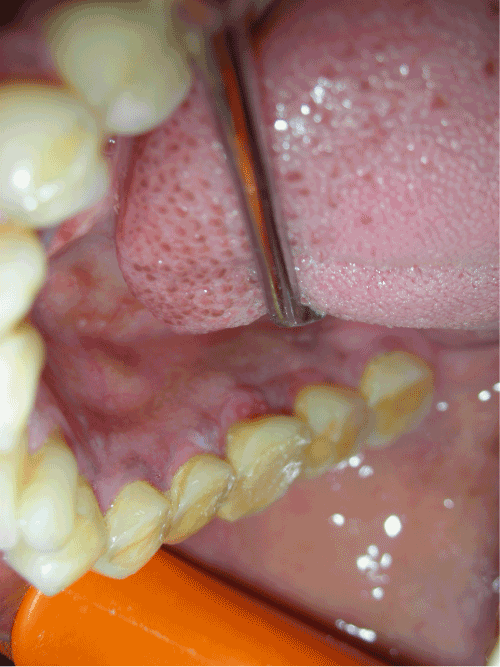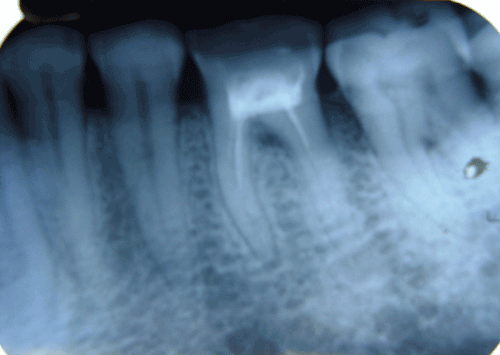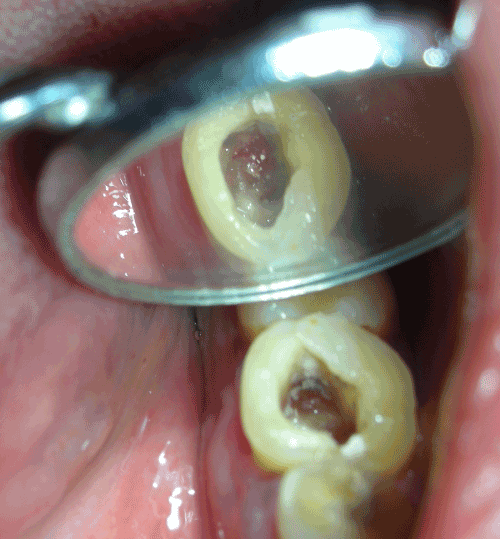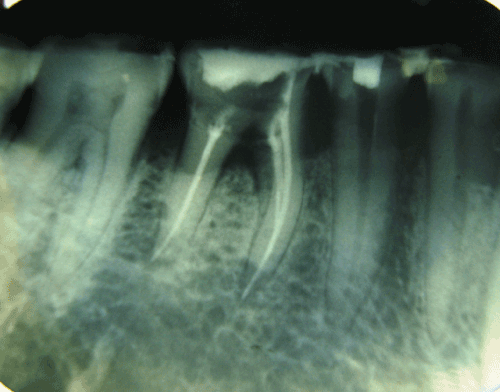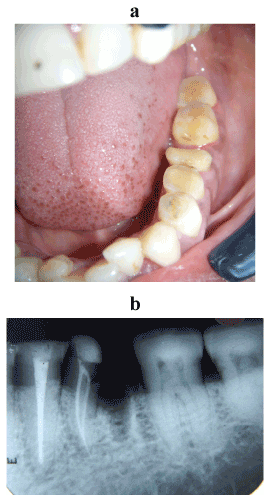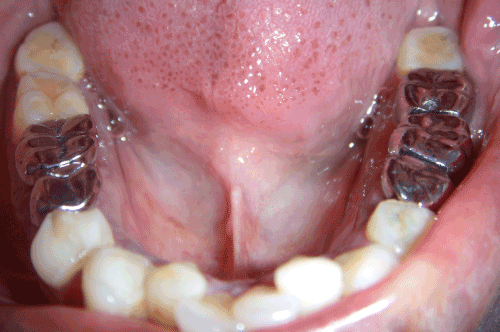|
|
| Ashima Bali Behl* |
| Luxmi Bai Institute of Dental Sciences and Hospital, Sirhind road, Patiala, Punjab, India |
| *Corresponding author: |
Ashima Bali Behl
Luxmi Bai Institute of Dental Sciences and Hospital
Sirhind road, Patiala, Punjab, India
E-mail: ashimabali2@yahoo.co.in |
|
| |
| Received January 24, 2012; Published September 27, 2012 |
| |
| Citation: Behl AB (2012) Hemisection of a Multirooted Tooth-A Case Report. 1:336. doi:10.4172/scientificreports.336 |
| |
| Copyright: © 2012 Behl AB. This is an open-access article distributed under the terms of the Creative Commons Attribution License, which permits unrestricted use, distribution, and reproduction in any medium, provided the original author and source are credited. |
| |
| Introduction |
| |
| Root canal treatment usually fails when treatment falls short of acceptable standards. The reason many teeth do not respond to root canal treatment is because of procedural errors that prevent the control and prevention of intracanal endodontic infection. In truth, a procedural accident often impedes or makes it impossible to accomplish appropriate intracanal procedures. Thus, there is potential for failure of root canal treatment when a procedural accident occurs during the treatment of infected teeth [1]. |
| |
| Perforations are regarded as serious complications in dental practice and pose a number of diagnostic and management problems [2]. |
| |
| Perforations occur primarily through three possible mechanisms: procedural errors occurring during root canal treatment or postspace preparation, resorptive processes and caries. Most perforations result from procedural errors. Errors leading to these defects include bur perforation during access opening or during the search for canal orifices, excessive removal of dentine in the danger zone either with hand or rotary instruments, misdirected files during canal negotiation, unsuccessful attempts at bypassing separated instruments and misaligned instruments during post-space preparation [3]. |
| |
| However, when teeth are of strategic importance perforation repair is clearly indicated whenever possible [4]. Unfortunately, however, there is a paucity of evidence-based research upon which treatment decisions can be based. |
| |
| Weine [5] has listed the following indications for tooth resection. |
| |
| Periodontal indications |
| |
| 1. Severe vertical bone loss involving only one root of multi-rooted teeth. |
| |
| 2. Through and through furcation destruction. |
| |
| 3. Unfavourable proximity of roots of adjacent teeth, preventing adequate hygiene maintenance in proximal areas. |
| |
| 4. Severe root exposure due to dehiscence. |
| |
| Endodontic and restorative indications |
| |
| 1. Prosthetic failure of abutments within a splint: If a single or multirooted tooth is periodontally involved within a fixed bridge, instead of removing the entire bridge, if the remaining abutment support is sufficient, the root of the involved tooth is extracted. |
| |
| 2. Endodontic failure: Hemisection is useful in cases in which there is perforation through the floor of the pulp chamber, or pulp canal of one of the roots of an endodontically involved tooth which cannot be instrumented. |
| |
| 3. Vertical fracture of one root: The prognosis of vertical fracture is hopeless. If vertical fracture traverses one root while the other roots are unaffected, the offending root may be amputed. |
| |
| 4. Severe destructive process: This may occur as a result of furcation or subgingival caries, traumatic injury, and large root perforation during endodontic therapy. |
| |
| Contraindications |
| |
| |
| a. Strong adjacent teeth available for bridge abutments as alternatives to hemisection. |
| |
| b. Inoperable canals in root to be retained. |
| |
| c. Root fusion-making separation impossible. |
| |
| Hemisection (removal of one root) involves removing significantly compromised root structure and the associated coronal structure through deliberate excision [6]. This procedure represents a form of conservative dentistry, aiming to retain as much of the original tooth structure as possible. The results are predictable, and success rates are high if certain basic considerations are taken into account [7]. |
| |
| Case Report |
| |
| A 50 year old female patient reported to the department with the chief complaint of pain in the lower left posterior tooth previously treated by root canal therapy two months back. The offending tooth was associated with a localised swelling on the lingual side and generalized severe attrition was present (Figure 1). The teeth 35 and 36 were tender on percussion. A diagnostic radiograph revealed that 36 was incompletely obturated with perforation in the pulpal floor and had grade II furcation involvement, whereas 35 was associated with periapical changes (Figure 2). |
| |
|
|
Figure 1: Offending tooth association with a localized swelling on the lingual side. |
|
| |
|
|
Figure 2: Pulpal floor having grade II furcation involvement. |
|
| |
| It was decided to treat 35 endodontically and retreat 36 followed by hemisection procedure for 36. The existing gutta percha was removed from the canals of 36 using solvent (endosolv) and H files (mani). |
| |
| Perforations were seen on the pulpal floor which was sealed using GIC (Figure 3a). |
| |
|
|
Figure 3a: Perforations on the pulpal floor which were sealed using GIC. |
|
| |
| The canals of both the teeth were prepared using stainless steel files by step back technique. |
| |
| The obturation was carried using lateral condensation with 2% gutta percha cones and AH plus resin based sealer (Figure 3b). The access cavity was restored with IRM and the patient was reviewed after 15 days and hemisection procedure was carried out. (Figures 4a and 4b) Decision was made to extract the distal root. |
| |
|
|
Figure 3b: Obturation carried out using lateral condensation with gutta percha cones and AH plus resin based sealer. |
|
| |
|
|
Figure 4: The access cavity was restored with IRM. |
|
| |
| Post endodontic restoration was done with composite resin and a three unit fixed partial denture involving 35, 36 and 37 was given (Figure 5). |
| |
|
|
Figure 5: Post endodontic restoration was done with composite resin. |
|
| |
| Discussion |
| |
| As practitioners of the art and science of dentistry we owe our patients to be able to provide a wide range of treatment options based on, the clinical situation, age, economical considerations of the patient and the best available clinical evidence of successful treatment modalities. |
| |
| The loss of posterior teeth can result in several undesirable sequelae, hence a guiding principle should be followed to try and maintain what is present. This case study presents a treatment available in cases of extensive iatrogenic perforations in the floor of molars. |
| |
| Hemisection has been used successfully to retain teeth with perforation involving furcation. Various resection procedures described are: |
| |
| a) Root amputation |
| |
| b) Hemisection |
| |
| c) Radisection |
| |
| d) Bisection |
| |
| Root amputation refers to removal of one or more roots of multirooted tooth while other roots are retained. Hemisection denotes removal or separation of root with its accompanying crown portion of mandibular molars. Radisection is a newer terminology for removal of roots of maxillary molars. Bisection/bicuspidization is the separation of mesial and distal roots of mandibular molars along with its crown portion, where both segments are then retained individually [5]. |
| |
| It is important to consider the following factors before deciding to undertake any of the resection procedures. |
| |
| • Advanced bone loss around one root with acceptable level of bone around the remaining roots. |
| |
| • Angulation and position of the tooth in the arch. A molar that is buccally, lingually, mesially or distally titled, cannot be resected. |
| |
| • Divergence of the roots - teeth with divergent roots is easier to resect. Closely approximated or fused roots are poor candidates. |
| |
| • Length and curvature of roots - long and straight roots are more favourable for resection than short, conical roots. |
| |
| • Feasibility of endodontics and restorative dentistry in the root/ roots to be retained. |
| |
| For this patient, hemisection was selected for the treatment of incomplete endodontically treated teeth with perforation in the floor close to the distal root and a three unit fixed partial denture involving 35, 36 and 37 was given. The distal root was resected because of the location of the perforation. The literature on distal root resection is limited; more often, this root is retained and the mesial root is removed. However, the distal root is broader and straighter, making it more suitable as an abutment. The mesial root contains a longitudinal groove, which decreases its surface area and contraindicates the use of posts. |
| |
| Implant therapy is a predictable option with good functionality [8]; however, in this case the patient chose an alternative treatment because of financial consideration and her desire to retain the teeth. |
| |
| Hemisection allows for physiologic tooth mobility of the remaining root, which is thus a more suitable abutment for fixed partial dentures than an osseointegrated counterpart [9]. The smaller size of the occlusal tables, under-contouring of the embrasure spaces and ensuring that the crown margin encompasses the furcation are all factors in the high success rates observed with hemisection therapy [10]. |
| |
| Conclusion |
| |
| The prognosis for hemisection is the same as for routine endodontic procedures provided that case selection has been correct, the endodontics has been performed adequately, and the restoration is of an acceptable design relative to the occlusal and periodontal needs of the patient. |
| |
| Root amputation and hemisection should be considered as another weapon in the arsenal of the dental surgeon, determined to retain and not remove the natural teeth. With recent refinements in endodontics, periodontics and restorative dentistry, hemisection has received acceptance as a conservative and dependable dental treatment and teeth so treated have endured the demands of function. In conclusion, hemisection can be considered a suitable alternative to extraction and should be discussed with patients, during consideration of treatment options. The results of hemisection are predictable, and success rates are high if certain basic considerations are taken into account. |
| |
| |
| References |
| |
- Siqueira JF Jr (2001) Aetiology of root canal treatment failure: why well-treated teeth can fail. Int Endod J 34: 1-10.
- Regan JD, Witherspoon DE, Gutmann JL (1998) Prevention, identification and management of tooth perforation. Endod Pract 1: 24-40.
- Regan JD, Witherspoon DE, Foyle DM (2005) Surgical repair of root and tooth perforations. Endodontic topics 11: 152-178.
- Menezes R, da Silva Neto UX, Carneiro E, Letra A, Bramante CM, et al. (2005) MTA repair of a supracrestal perforation: a case report. J Endod 31: 212-214.
- Weine FS (1996) Endodontic Therapy. (5th edn).
- Bühler H (1994) Survival rates of hemisected teeth: an attempt to compare them with survival rates of alloplastic implants. Int J Periodontics Restorative Dent 14: 536-543.
- Kurtzman GM, Silverstein LH, Shatz PC (2006) Hemisection as an alternative treatment for vertically fractured mandibular molars. Compend Contin Educ Dent 27: 126-129.
- Bashutski JD, Wang HL (2007) Common implant esthetic complications. Implant Dent 16: 340-348.
- Kost WJ, Stakiw JE (1991) Root amputation and hemisection. J Can Dent Assoc 57: 42-45.
- Rapoport RH, Deep P (2003) Traumatic hemisection and restoration of a maxillary first premolar: a case report. Gen Dent 51: 340-342.
|
| |
| |

